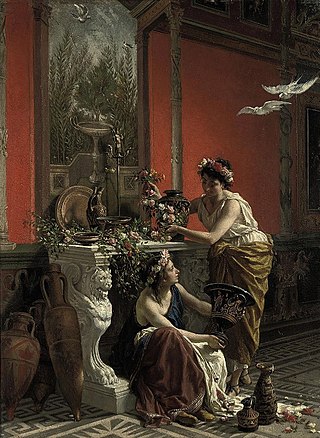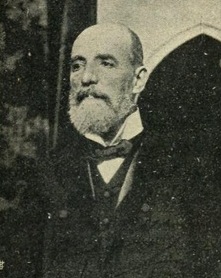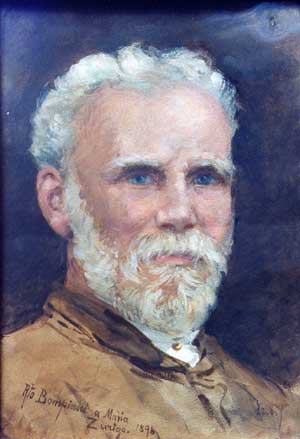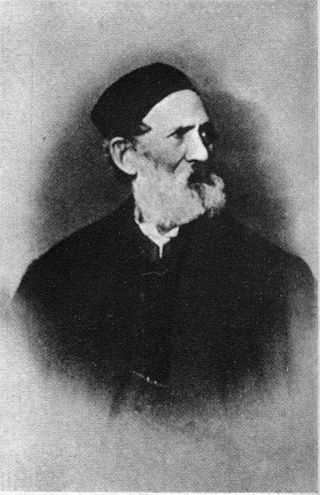Related Research Articles

Girolamo Siciolante da Sermoneta began his career as an Italian Mannerist painter but later adopted the reformist naturalism of Girolamo Muziano in the 1560s and 70s. He was active in Rome in the mid 16th century.

Bernardino India (1528–1590) was an Italian painter of the late Renaissance, born and mainly active in Verona.

Guglielmo Borremans or Guglielmo Fiamingo (1670–1744) was a Flemish painter whose documented career took principally place in Italy, in particular Naples, Cosenza and Sicily. Here he was one of the pre-eminent late-Baroque fresco painters of the first half of the 17th century who received multiple commissions to decorate churches and palaces.

Giacomo Boni was an Italian painter of the late-Baroque period, active mainly in Genoa.

Cesare Mariani was an Italian painter and architect of the late-19th century, active in Rome and Ascoli Piceno.

Giuseppe Nicola Nasini was an Italian painter of the Baroque period and active in Rome and Tuscany.

Giovanni Giacomo Barbelli was an Italian painter of the Baroque period, active in Lombardy. He was a canvas and fresco painter known for his religious and mythological scenes that decorate many churches and residences in Lombardy. He was a highly skilled draughtsman and a brilliant colorist. His work shows an inventive imagination and a thorough knowledge of perspective.

Amos Cassiòli was an Italian painter, of battle scenes, historical canvases and portraits. He worked in a Purismo style.

Cesare Maccari was an Italian painter and sculptor, most famous for his 1888 painting Cicerone denuncia Catilina.

Ettore Tito was an Italian artist particularly known for his paintings of contemporary life and landscapes in Venice and the surrounding region. He trained at the Accademia di Belle Arti in Venice and from 1894 to 1927 was the Professor of Painting there. Tito exhibited widely and was awarded the Grand Prize in painting at the 1915 Panama–Pacific International Exposition in San Francisco. In 1926 he was made a member of the Royal Academy of Italy. Tito was born in Castellammare di Stabia in the province of Naples and died in Venice, the city which was his home for most of his life.

Nicolò Barabino was an Italian academic painter of religious and historical subjects, active in Florence and Genoa.

Pietro Bardellino was an Italian painter in the Rococo style.

Fedele Gioffredo Fischetti was an Italian painter of the Neoclassical period. Most of his works are frescoes of an allegorical or mythological nature.

Francesco Podesti was an Italian painter, active in a Romantic style. Together with Francesco Hayez and Giuseppe Bezzuoli, he is considered one of the greatest Italian painters of the first half of the 19th century. He was prolific in his large canvases on historical subjects. He is best known for his fresco work, including those in the Hall of the Immacolata in the Vatican Museum.

Roberto Bompiani was an Italian painter and sculptor.

Adeodato Malatesta was an Italian painter, trained in a grand Neoclassical style, depicting mostly of sacred and historic subjects.

Giovanni Bernardino Pollinari was an Italian painter, mainly of historic and sacred canvases, as well as portraits.

Giuseppe Sciuti was an Italian painter.

Alberto Pasini was an Italian painter. He is best known for depicting Orientalist subjects in a late-Romantic style.

Giovanni Maria Ciocchi was an Italian painter and art critic, active during the Baroque period. He was born into a family of artists, and it is not clear if he is related to Giovanni Maria Ciocchi del Monte from Perugia, who became Pope Julius III. it is not clear that Giovanni Maria is related to the 16th century painter Ulisse Ciocchi.
References
- ↑ Encyclopedia, Dizionario Biografico degli Italiani - Volume 87 (2016), entry by Alessandro Malinverni.